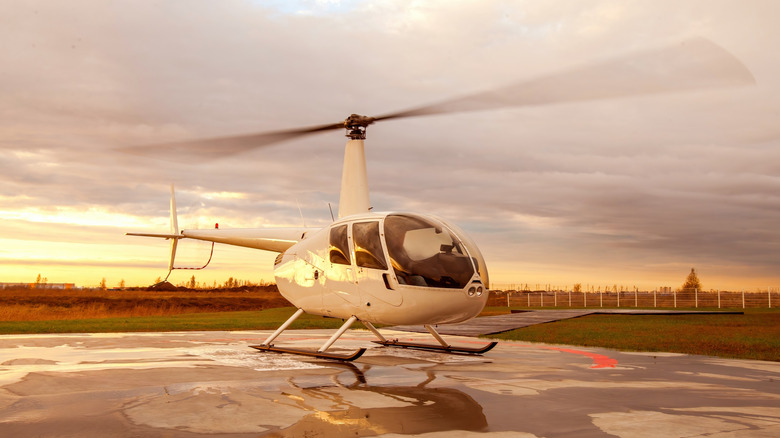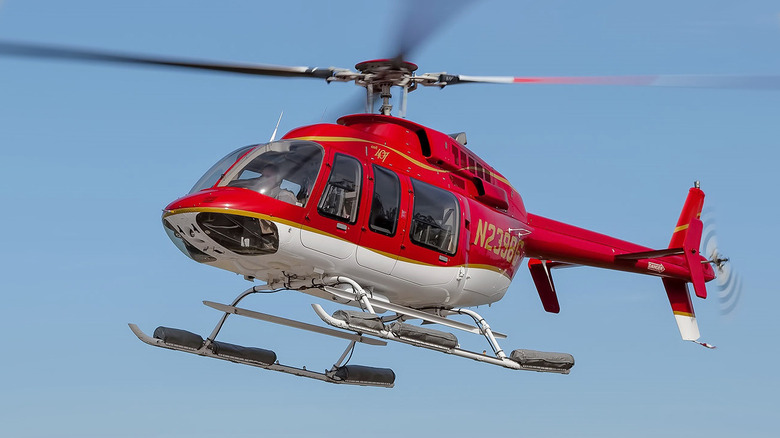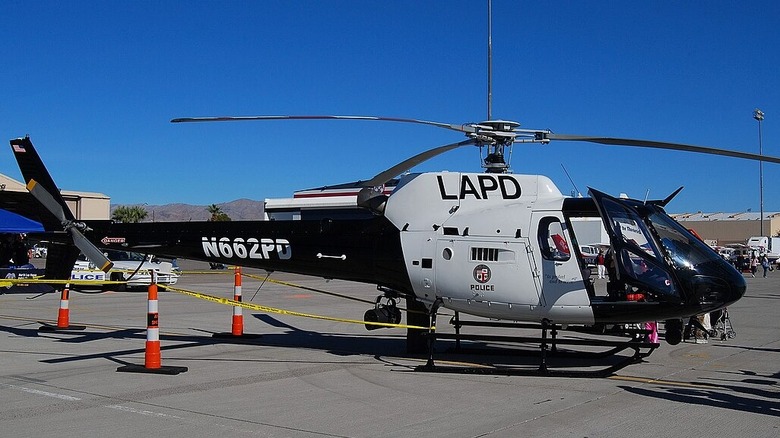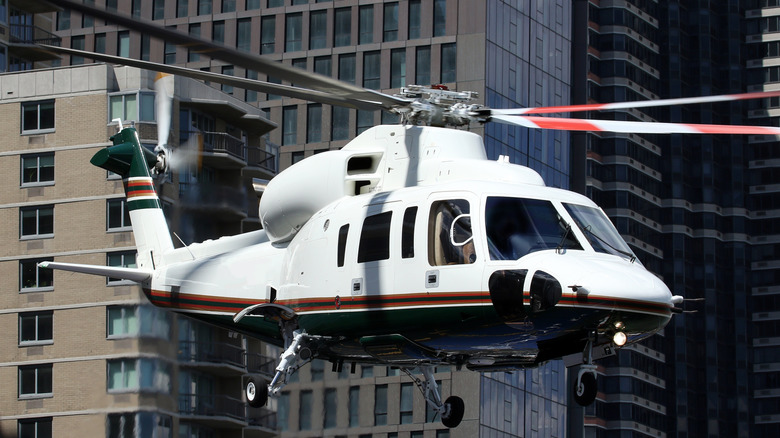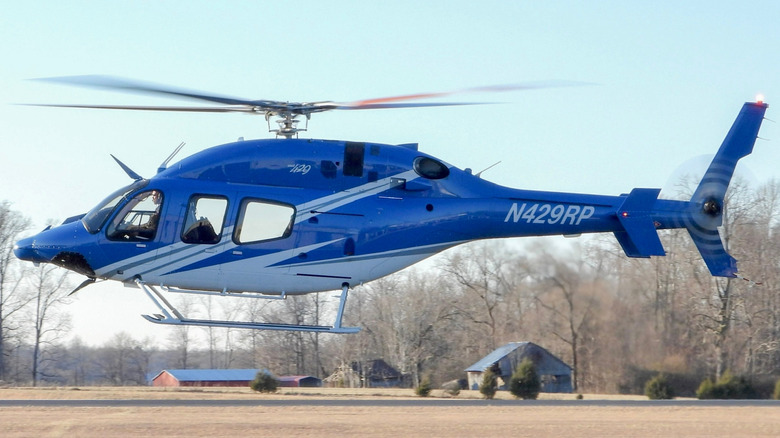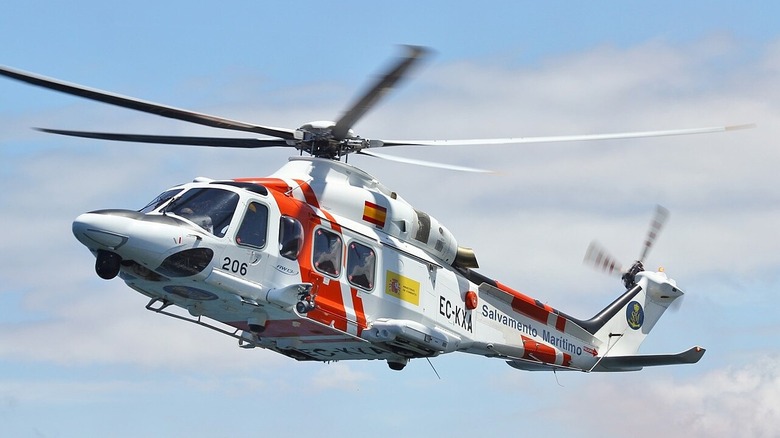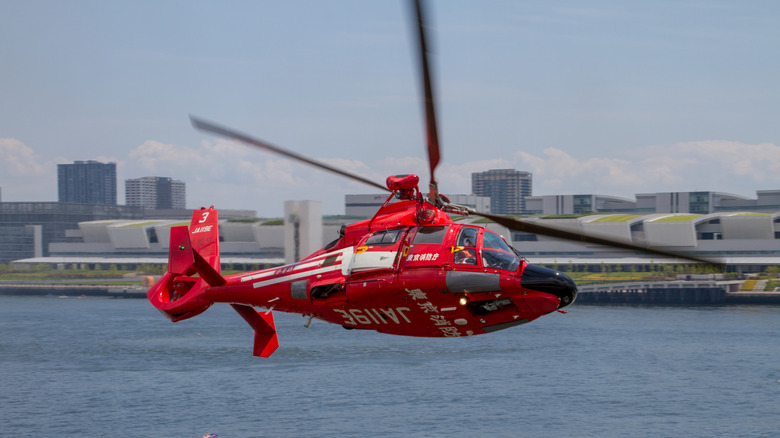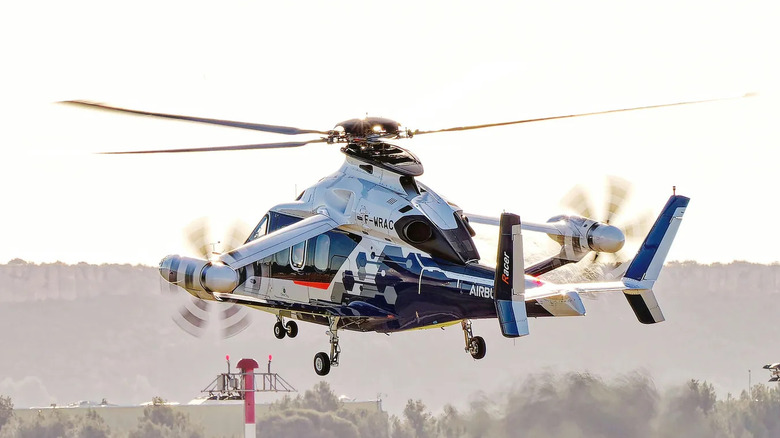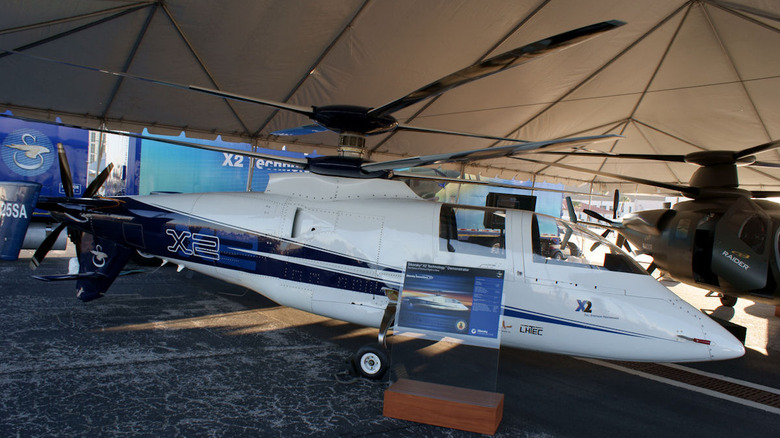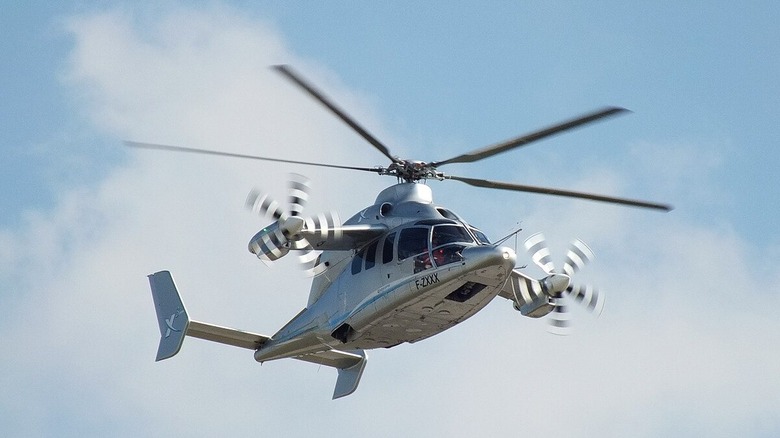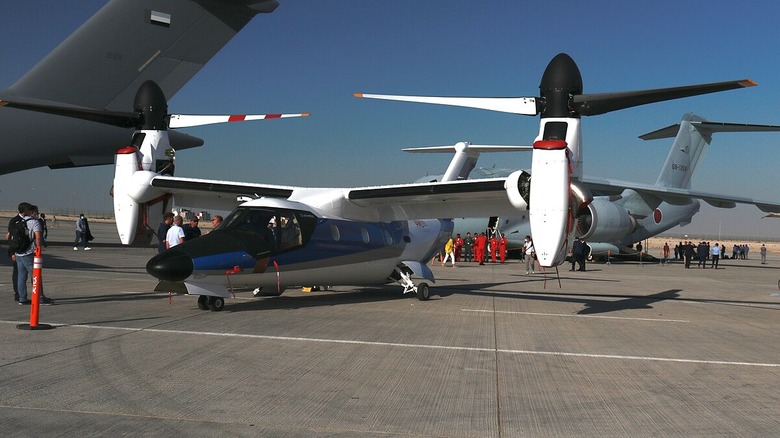10 Of The Fastest Civilian Helicopters, Ranked By Top Speed
Since its groundbreaking invention in 1939, the helicopter has steadily transformed the world of transport, though it took a decade or two to really reach its potential. The Korean War served as the first large-scale stage of the helicopter when the Bell 47, one of the most iconic military helicopters in history, proved to be a literal lifesaver as it transported the wounded from the battlefield to hospitals in rear areas.
From its military roots, the helicopter has branched out into many civilian applications. Its unique ability to hover, attain high speed, and requirement for a small landing footprint make it a perfect fit for a wide range of tasks. Today, modern civilian helicopters are involved in everything from transporting donated organs to ferrying CEOs and pop stars to rescuing stranded adventurers and aiding law enforcement in chasing down criminals.
Though often spoken of in the same breath as airplanes, helicopters, as a general rule, are not as fast as their fixed-wing siblings. Some of the fastest private jets in the sky today can achieve upward of 700 mph, but most helicopters operate between 150 and 160 mph. While those speeds might not raise many eyebrows, the pure utility of helicopters makes them an integral part of today's transportation network.
In honor of the helicopter's convenience and life-saving service, we examine some of the fastest choppers on the civilian market, ranked by top speed.
Bell 407 — 161 mph
Founded in Buffalo, New York on July 10, 1935, Bell is one of the oldest aviation firms in the country. The company initially focused on building fixed-wing fighter planes like the P-39 Airacobra but pivoted to helicopters with the Model 30 in 1941. The Bell 47 model performed some of the same duties as the later Army workhorse Huey helicopter did in the skies over the battles of the Korean War , and the company is still in the chopper business all these years later.
The Bell 407 has more than a quarter century of history, with the first production bird taking flight in November 1995. The modern version uses a Rolls-Royce 250-C47E/4 turbine engine, which makes 862 shaft horsepower (shp). Depending on its configuration, it can accommodate one pilot and up to six passengers as long as it does not exceed its maximum gross weight limitation of 5,250 pounds (6,000 pounds with an external load).
With a maximum cruise speed of 153 mph, the Bell 407 is a quick ride, even though it may not match the speed of the fastest civilian birds or the power of military airframes. Bell rates the Vne speed — aviation jargon for the maximum safe speed an airframe should not exceed, even in a dive — at 161 mph.
Airbus H125 — 176 mph
First introduced in 1974 as the Aérospatiale AS350, the H125 has had a long and storied career. A member of the Ecureuil family of Airbus helicopters, it was built under the name Eurocopter and was previously known as the AS350 Squirrel and AS350 AStar. In 2015, Airbus tweaked its naming conventions. Since then, it has operated as the H125.
Irrespective of its name, the helicopter stands out for its adaptability and agility as a single-engine chopper, earning praise for its smooth operation and diverse mission capability. At the heart of the H125 is a Safran Arriel 2D engine generating 952 shp at takeoff power. The H125 boasts a maximum takeoff weight of 5,225 pounds (6,173 pounds with an external load). It can house up to two pilots and six passengers, making it an ideal choice for a wide range of tasks.
Airbus offers variations of the H125 tailored for search and rescue, law enforcement, firefighting, and powerline missions. At maximum takeoff weight (MTOW), it can cover a range of up to 340 nautical miles (NM) and operate for 4 hours and 27 minutes at a fast cruise speed of 156 mph. This makes it one of the fastest police helicopters on the market, although most departments likely do not utilize its maximum speed of 176 mph.
Sikorsky S-76 — 178 mph
Aside from life-saving capabilities, helicopters are often used to transport high-profile individuals. The Sikorsky S-76, introduced in 1977, is a prime example of this. It has been the preferred mode of transportation for heads of state, serving as the primary heli transportation for 10 nations. It has ferried everyone from CEOs to oil-rig roughnecks heading offshore, cementing its status as a versatile people hauler.
For helicopter enthusiasts, the S-76 may ring a bell as the civilian counterpart of the UH-60 Blackhawk, known for its roles in Black Hawk Down and Operation Neptune Spear. The S-76 shares a similar mechanical structure with its military sibling, but it focuses more on comfortable transportation. It also serves as an air ambulance and search-and-rescue platform. One of its key features is the ability to fly with a single pilot, reducing costs for corporations and other for-profit organizations. With a 12-person capacity, this mid-sized chopper is not just a mode of transportation but a party bus in the sky.
The S-76C++/ model uses two Arriel S2S engines that deliver 923 shp at maximum takeoff power and 853 shp in operation. The top-of-the-line S-76D replaces those with 1,077 shp Pratt & Whitney PW210S turboshafts. Sikorsky sets the maximum speed at 178 mph, making it a pretty speedy helicopter for all of your CEO-hauling needs.
Bell 429 — 178 mph
Once again, Bell takes a prominent place with the versatile Bell 429, a helicopter that shares its American roots with the S-76. This adaptable aircraft is a key player in various sectors, including VIP transport, public safety, helicopter emergency medical services (HEMS), and the energy field. Its customizable cabin is designed with a focus on comfort and quiet operation.
The Bell 429 has its roots in a previous generation of helicopters. It was developed from the Bell 206L LongRanger and 400/440 TwinRanger of the mid-1980s. With development reaching back to those choppers, Bell introduced what would become the 429 at the 2005 Heli-Expo as the GlobalRanger. It went operational in 2009, primarily as a medical helicopter.
With a fuel capacity of 217 gallons, the standard Bell 429 has a range of approximately 425 miles and a typical cruising speed of between 172 and 178 mph, depending on conditions like weather and load. The 429 weighs 4,465 pounds empty and boasts a maximum internal load of up to 3,255 pounds, with an additional 3,000 pounds of cargo hook capacity. However you load it, the 429 can't take off weighing more than 8,000 pounds total.
Leonardo AW139 — 192 mph
Leonardo da Vinci's creations — some of which you may not have realized he invented – covered nearly every conceivable genre of study. He famously designed (but never built) a helicopter-like contraption we know as the aerial screw. This is why Italian conglomerate Finmeccanica chose the name Leonardo when it rebranded in 2017. It claims to have been inspired by Da Vinci's genius for systemic thinking. The Leonardo AW139 is one product of the company's approach to aviation.
Geared up to service the medical, security, and energy fields, the AW139 is a sizable helicopter capable of carrying one to two crew members and as many as 15 passengers. Of course, not all configurations prioritize passenger transport. In a medical configuration, it can accommodate two stretchers, up to five medical personnel, and a full suite of life-support equipment.
The AW139 is a high-performance helicopter with an overall length of over 54 feet (rotors included) and a height of 16 feet. Its maximum gross weight is 14,110 pounds, and its maximum range is 737 miles. Powered by a pair of Pratt & Whitney PT6C-67C turboshaft engines, each capable of producing up to 1,700 hp, the AW139 can reach speeds of as much as 192 mph at maximum output.
AS365 Dauphin — 201 mph
This one is a little sneaky, as the AS365 Dauphin — formerly of Eurocopter and now of Airbus — is used for a quasi-military mission. The Dauphin is the helicopter you've seen in movies rescuing mariners in distress as the Coast Guard's primary rescue platform. The Coast Guard, although primarily a military organization, is technically under the auspices of the Department of Homeland Security, a civilian agency. This is why we're calling it a civilian helicopter, so we can include it on this list for being speedy and cool.
The Dauphin has been in service with the Coast Guard since 1984, when the HH-65A debuted in its original version. Since then, various upgrades have kept it in service until the present day. Overall, the MH-65, as it is known now, has logged over 1.7 million hours of flight time for the Coast Guard. It has to be rugged and reliable, as lives depend on its successful operation.
The latest MH-65 is a dual-engined machine utilizing a pair of Arriel 2C/2C2 engines, each of which makes 853 shp. It's a powerful machine that can cruise at an impressive 170 mph and reach a maximum speed of 201 mph. If you're waiting in the water for a rescue, you might want the crew to risk pushing it that hard.
Airbus Racer — 252 mph
The 200 mph mark is rarified air for the civil helicopter arena, and companies are pressing to develop machines that reach higher speeds than ever. The Airbus Racer is something of an experimental airframe, and not (yet) ready for civilian mass production, but it shows enormous potential.
Currently, Airbus uses the Racer as a testbed for technology that could enter the market. One of its main focuses is developing an aerodynamic airframe. That's a goal of any aviation company, but just looking at the Racer clues viewers in on its next-gen potential. Aside from a sleek design, it features a pair of box-wing outriggers equipped with additional rotors and a twin-boom tail that forgoes the typical rear rotor setup.
The Airbus team set a goal of reaching a fast cruise speed of 253 mph, which it achieved within two months of the Racer's first flight. Test pilot Hervé Jammayrac later pushed it up to an impressive 260 mph. It achieved its incredible speed in part due to a design that produces a drag coefficient in the same range as Airbus's smallest models despite its larger size.
Advanced aerodynamics is all well and good, but there's no replacement for power, and the Racer has it in spades. A pair of Safran Aneto-1X engines each make 2,500 shp — 25% more than engines of similar volume. The potential of the Racer is yet to be maximized, but it looks like a promising upcoming addition to civilian aviation.
Sikorsky X2 — 288 mph
Airbus isn't the only aviation firm looking to break new barriers in the pursuit of speed. Sikorsky, under the ownership of Lockheed Martin, has its own experimental prototype. The X2 employs a non-traditional design to explore the helicopter's potential in a unique way.
The X2 uses a pair of rotors, one mounted above the other, similar to Russia's KA-52, the answer to America's AH-54 Apache attack helicopter. It's called a coaxial rotor system, and each main rotor can rotate and tilt in opposite directions. The system makes the X2 a marvel of maneuverability, as the counter-rotating blades can work in opposition to each other for faster turns. Think of tank treads turning in the opposite direction to spin.
While the coaxial rotors catch the eye first, what may go unnoticed is a pusher propellor, referred to as a propulsor, settled between the twin-boom tail. The propulsor helps the X2 get up to speed quickly and excel at low-level flight. Unlike some of the other fast helicopters on this list, the X2 is a single-engine design, using an LHTEC T800-LHT-801. The Light Helicopter Engine Turbine Company, a joint venture between Honeywell and Rolls-Royce, builds it. The engine makes 1,340 hp and drove the X2 to 288 mph in September 2010.
Although the X2's design was initially intended for use in conflict zones, Sikorsky has not ruled out the possibility of introducing this advanced technology to the civilian market if there is a demand. This potential expansion of the X2's applications is something that aviation enthusiasts can hope for.
Eurocopter X3 — 294 mph
If the X2 is good, the X3 must be better, right? Unfortunately, for aeronautical engineers, it's not that easy, though in this case there's some truth to the supposition. The Eurocopter X3 is considered a gyrodyne, a helicopter/plane hybrid. Like the CV-22 Osprey or the AW609 in the next section, it can take off and land like a helicopter but operates more like a fixed-wing aircraft while in flight, albeit a tad differently from a tilt-rotor craft.
The X3 uses a primary rotor like a helicopter for vertical operation and a pair of outrigger engines similar to the Airbus Racer for forward motion. The rear rotor is replaced by a pair of turboprop engines that quickly push it up to speed. It could only accommodate two people and was primarily envisioned for search and rescue operations in which speed is a life-saving (or denying) factor. There are no plans to utilize the X3 for transport missions.
In 2011, the X3 broke records by achieving a cruising speed of 267 mph using only 80% of its power. Three years later, in June 2013, it reached a top speed of 300 mph before the pilot reined it down to a cruise of 293 mph.
Alas, the day of the X3 is already over. After 199 test flights from which engineers gleaned reams of data, the airframe was retired and now lives a peaceful existence as an exhibit at the Bourget National Air and Space Museum outside of Paris.
Leonardo AW609 — 310 mph
Leonardo makes the list again, and the design of the AW609 would likely make its namesake proud. There is a space between helicopters and fixed-wing aircraft, most famously occupied by the game-changing CV-22 Osprey used by military organizations. Leonardo hopes to bring the hybrid tilt-rotor aircraft to the civilian world.
At a glance, the AW609 is clearly not your typical helicopter. Its engine nacelles remain vertical for takeoff and landing and then tilt to horizontal for flight. This allows it to achieve speeds rivaling fixed-wing aircraft while maintaining the convenience and small landing footprint of a helicopter. It also doesn't require a runway, so landing pads on hospitals or hovering over a sinking ship is very much in its wheelhouse.
Leonardo envisions the AW609 as having energy services and private transport applications but has especially high hopes in time-critical situations like search and rescue and medical evacuation. Its high-speed capability could save lives when seconds count.
It is not just speed at which the AW609 excels. It can achieve up to 25,000 feet of altitude – higher than many helicopters can fly — and features a comfortable, pressurized cabin. It is also specially designed to fly safely in icing conditions that could ground other aircraft, another testament to its potential under adverse weather conditions. The engines are the same Pratt & Whitney PT6C-67A turboshafts found in Leonardo's AW139, but in this unique configuration, they can push the AW609 up to 310 mph.
